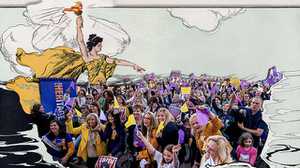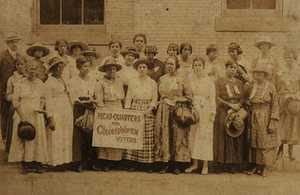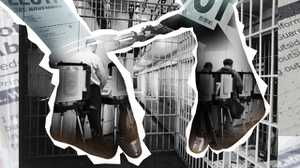Why Vote-by-mail Could Depress Native American Turnout on North Dakota Reservations
North Dakota’s new emphasis on mail-in balloting could mean fewer votes and less representation for Native American communities

This dispatch is part of a series in collaboration with The GroundTruth Project that explores the expansion of voting rights in communities across the U.S., in connection with The Vote, by American Experience, and as part of GroundTruth’s initiative called “On the Ground" with Report for America.
BISMARCK, N.D. — Sisters Joletta and Theodora Bird Bear live across from one another on a remote stretch of western North Dakota highway roughly nine miles east of Mandaree, a town of around 600 people on the Fort Berthold Indian Reservation. Their homes are just past a cluster of four roadside oil wells and before the recently paved intersection on the other side of the hill.
“Don’t look at Google,” said Joletta when offering directions to her home. “You’ll end up somewhere thirty miles away.”

Joletta and Theodora, Mandan Hidatsa members of the Three Affiliated Tribes, have spent most of their lives on rural Fort Berthold without accessible street addresses, nor mailboxes at the end of their long driveways.
To pick up her mail, Joletta drives to the Mandaree post office, where for more than twenty years her mother worked as the town postmaster. When she retired, Joletta succeeded her. All told, the Bird Bears staffed the Mandaree post office — a place of unique importance on North Dakota’s tribal lands — for more than forty years.
With many homes like the Bird Bears’ lacking accessible addresses or regular route postal delivery, the post office provides a critical communication line and medical delivery to largely rural areas with below-average internet access and spotty cell phone coverage. For activist Nicole Donaghy, a Hunkpapa Lakota from the Standing Rock Sioux Nation and the director at North Dakota Native Vote, the post office is “one of the very few lifelines that goes into a reservation.” It acts as a center of gravity for its region, a bedrock for community and a link to the country surrounding sovereign nations.

But in recent months, the pandemic has pushed a once-obscure idea of universal vote-by-mail into the mainstream, especially in North Dakota as it emerged as one of the states with the highest rates of COVID-19 transmission in the country.
North Dakota is among the states that have pivoted quickly towards a mail-in system for the upcoming election, scaling back in-person voting options this November by close to 50 percent. For the Bird Bear sisters who really want to cast their ballots in person, that means an hour-long drive to the nearest polling place. This year, their county is offering just two, both more than forty miles from their homes.
With just two weeks to go until election day, tribal groups in North Dakota are grappling with how to preserve reservation turnout in the revamped pandemic election system. Old ways like large carpools and busses to the polls are no longer safe solutions, and most of Donaghy’s appeals to election officials to expand in-person voting options have fallen flat.

In rural communities like the one on Fort Berthold, reliance on an underfunded, reduced hours post office could become a vulnerability this election. Activists argue that North Dakota’s new emphasis on mail-in balloting could mean fewer votes and less representation for Native American communities.
Many residents of North Dakota’s five tribal reservations must often drive tens of miles in one direction to reach the nearest post office. That distance only multiplies in the process of mailing a ballot application and picking up and sending back the ballot.
Donaghy, whose work is a rare bridge between North Dakota’s tribal lands and the state’s leadership, fears that a mostly mail-in election this November could throw the limits of reservation postal services into sharp relief, with their remote routes, the lack of easily accessible addressing and diminished funding.

Native American voting has found a new momentum here in the last few years, but that may be at risk this year as a mostly mail-in election jeopardizes the ballots of thousands of voters on reservations. In North Dakota, the pandemic increased the amount of work needed to cast a ballot on reservations and added to an existing climate of distrust between tribal groups and the state’s election officials, a rift that grew deeper over the last few years.
Two years ago, North Dakota passed a new voter ID law, requiring residents to show an official, state-registered address on their ID in order to vote. In a state where many reservation residents rely on P.O. Boxes and do not know their registered street address, Grant Christensen, a professor of Native American law at the University of North Dakota, said the law amounted to “a concerted effort to disenfranchise Native Americans in North Dakota.”
Even as the new voter ID requirements posed new barriers to voting, the law rallied voters to join in one of the most effective get-out-the-vote efforts ever organized on North Dakota’s tribal lands. That year, reservation turnout nearly doubled compared to the previous midterm — from approximately 6,987 ballots cast in 2014 on four of the state’s reservations to 11,791 in 2018, according to Native Vote. That’s an increase from about 26 percent to 44 percent of the eligible voters across the state’s reservations, based on Census estimates.
But with coronavirus cases climbing at an unmitigated pace in North Dakota, the kind of grassroots work that produced that result has become much harder.
And as the state gears up for an election that is expected to rely on mail-in ballots more than any other in U.S. history, the operations of the Mandaree post office and its postal service, with increasingly spotty coverage, become even more crucial.
“It seems like it’s going to take a determined voter to make sure their vote is cast,” Joletta said.
For Christensen, the disparities highlighted by a mostly mail-in election in North Dakota mark just the latest episode in a long fight for Indigeneous voting rights in the United States. Even after Native Americans were granted formal citizenship in 1924, many states complied with Native American voting rights reluctantly and late, with the last state legally acknowledging Native American suffrage in 1962.
And Christensen believes that the 2018 voter ID dispute may have led to less cooperation between tribal leadership and the state government leading up to the logistically complicated 2020 election. “There’s an animosity between tribal communities and the state here in the Dakotas that isn’t replicated in some of the states that have partnered with the tribes to make vote-by-mail work,” Christensen said.

For activist Nicole Donaghy, a reliance on mail-in voting puts reservation votes in jeopardy. “Those communities are already hard to reach by our grassroots organizing standards, but having the state come in and try to reach every voter to try to get a vote-by-mail ballot — it’s not going to turn out well for us,” she said.
Donaghy says that “there are too many inadequacies for reservations to go fully vote-by-mail,” so, in the lead-up to the election, she has logged hundreds of hours trying to counteract a possible dive in Indigenous turnout. In an August letter, she called on county auditors to adjust their election day plans and to expand options for in-person voting. Most of the auditors have not responded.
Among the counties that never wrote back was Dunn, which overlaps the Fort Berthold reservation and includes the Bird Bears’ houses. “We request that you make available secure drop boxes in each community on the reservation,” wrote Native Vote to the county in August. “It is our hope that we can work together to promote fair and equitable voting access for all citizens in North Dakota.”

In the primary, Fort Berthold had only two drop boxes according to Representative Ruth Buffalo, D-Fargo, who looked into the availability of no-cost drop boxes on reservations in the June election.
And, even before the pandemic, Dunn County cut back in-person voting locations from eight to just two — eliminating one polling place a few miles from the Bird Bears' homes — as officials embraced vote-by-mail in a bid to boost overall turnout.
“This pushes the county further and further away from us,” argued Joletta.
But the Bird Bear sisters will not be deterred. As before, they will forgo voting by mail at their old family post office in Mandaree. Instead, they will drive more than fifty miles south to cast their ballots at the Dunn County courthouse.
“I think it’s important to see my ballot go into the system,” Theodora said.
Adam Willis reports for The Forum of Fargo-Moorhead in North Dakota, where he covers statewide business issues and elections. This dispatch is part of a series called “On the Ground” with Report for America, an initiative of The GroundTruth Project. Follow him: @adampwillis
Read the first dispatch: Polygamy, Statehood and the First Woman to Vote
Read the second dispatch: Unlocking the Vote of Connecticut’s Formerly Incarcerated
Read the third dispatch: Overcoming Barriers for Native American Voters
Read the fourth dispatch: The Legacy of Activism in the Motor City
Read the fifth dispatch: How Shifting Demographics Are Changing a 2020 Swing State
Read the sixth dispatch: Getting Out the Latino Vote in Rural California
Read the seventh dispatch: ‘Washed Away by the Majority’
Read the eighth dispatch: Helping People in Jail Exercise their Right to Vote in North Carolina
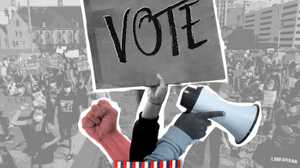
The ratification of the 19th Amendment led to the single greatest expansion of voting rights in the history of the United States. But in the 100 years since its ratification in 1920, millions of American citizens have faced barriers to the vote. In this series of essays, American Experience, in collaboration with the GroundTruth Project’s Report for America initiative, explores the many ways the fight for voting rights continues today. From overcoming felon disenfranchisement in Connecticut, to exposing gerrymandering in Texas, these On the Ground dispatches highlight how Americans continue working to have a voice in the democratic process.
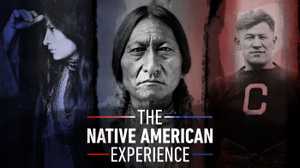
After centuries of encroachment, warfare and neglect, Native Americans remain a vital force in the life and culture of America. In this collection, explore stories celebrating and honoring the history and lives of Native Americans—throughout history and today.




